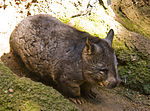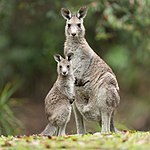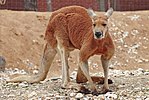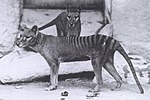| This article needs additional citations for verification. Please help improve this article by adding citations to reliable sources. Unsourced material may be challenged and removed. Find sources: "List of marsupials by population" – news · newspapers · books · scholar · JSTOR (February 2024) (Learn how and when to remove this message) |
This is a list of estimated global populations of Marsupials species. This list is not comprehensive, as not all Marsupials have had their numbers quantified.
| This list is incomplete; you can help by adding missing items. (April 2017) |
| Common name | Scientific name | IUCN Red List status | Trend | Global population estimate (year) | Population notes | Range | Image |
|---|---|---|---|---|---|---|---|
| Common wombat | Vombatus ursinus | LC | >915,090 (2020) | Only includes subpopulations from three islands (Maria, Flinders, and Tasmania) of two subspecies (V. u. ursinus and V. u. tasmaniensis). Mainland subspecies (V. u. hirsutus) numbers are not known. | 
|

| |
| Southern hairy-nosed wombat | Lasiorhinus latifrons | NT | 1,300,000 (2016) | 
|

| ||
| Northern hairy-nosed wombat | Lasiorhinus krefftii | CR | 315 (2021) | 
|

| ||
| Koala | Phascolarctos cinereus | VU | 100,000–500,000 | 
|

| ||
| Eastern grey kangaroo | Macropus giganteus | LC | >12,977,181 (2021) | Population estimate is only for the areas within Australia where commercial harvesting occur. The actual national populations would be significantly higher. | 
|

| |
| Western grey kangaroo | Macropus fuliginosus | LC | >2,571,158 (2021) | Population estimate is only for the areas within Australia where commercial harvesting occur. The actual national populations would be significantly higher. | 
|

| |
| Red kangaroo | Osphranter rufus | LC | >10,848,470 (2021) | Population estimate is only for the areas within Australia where commercial harvesting occur. The actual national populations would be significantly higher. | 
|

| |
| Wallaroo, euro | Osphranter robustus | LC | >2,338,076 (2021) | Population estimate is only for the areas within Australia where commercial harvesting occur. The actual national populations would be significantly higher. | 
|

| |
| Antilopine kangaroo | Osphranter antilopinus | LC | [data missing] | 
|

| ||
| Tasmanian devil | Sarcophilus harrisii | EN | 140,000 | 
|

| ||
| Thylacine | Thylacinus cynocephalus | EX | 0 (1936) | Last known individual died on 7 September, 1936. | 
|

| |
| Brown-eared woolly opossum | Caluromys lanatus | LC | 160,000,000 (2019) | 
|

| ||
| Brown four-eyed opossum | Metachirus nudicaudatus | LC | 128,000,000 (2019) | 
|

| ||
| Gray four-eyed opossum | Philander opossum | LC | 121,000,000 (2019) | 
|

| ||
| Linnaeus's mouse opossum | Marmosa murina | LC | 104,000,000 (2019) | 
|

|
See also
- Lists of organisms by population
- Lists of mammals by population
- Lists of elephant species by population
References
- Knoblauch, Wiebke; Carver, Scott; Driessen, Michael M.; Gales, Rosemary; Richards, Shane A. (4 September 2023). "Abundance and population growth estimates for bare-nosed wombats". Ecology and Evolution. 13 (9): e10465. Bibcode:2023EcoEv..1310465K. doi:10.1002/ece3.10465. PMC 10477484. PMID 37674647.
- Swinbourne, Michael (November 2018). "Chapter 8: The species-wide distribution and abundance of southern hairy-nosed wombats (Lasiorhinus latifrons)". Southern hairy-nosed wombats: when, where, how many, and why (PhD thesis). University of Adelaide, School of Biological Sciences (published 2019). hdl:2440/120414. Retrieved 2024-02-27.
- Swinbourne, Michael; Taggart, David; Ostendorf, Bertram (2021). "The population status of southern hairy-nosed wombats (Lasiorhinus latifrons). I. Distribution and abundance". Australian Mammalogy. 43 (1). CSIRO Publishing: 6. doi:10.1071/AM20016. hdl:2440/127470. ISSN 0310-0049. S2CID 225375892. Retrieved 2024-02-27. pp. 5–6:
Therefore, the population numbers provided in this study should only be considered to be applicable at the time of the study (2016) and not for other times.
- Lamond, Belle (2019-02-28). "Northern hairy-nosed wombat". Australian Wildlife Conservancy. Retrieved 2024-02-04.
- ^ DCCEEW (2022). "Macropod quotas and harvest statistics for NSW, QLD, SA and WA commercial harvest areas" (PDF). p. 1. Retrieved 2024-03-03.
- "Tasmanian Museum and Art Gallery | Thylacine mystery solved in TMAG collections". Tasmanian Museum and Art Gallery. Department of State Growth. 5 December 2022. Retrieved 2024-02-04.
- ^ Greenspoon, Lior; Krieger, Eyal; Sender, Ron; Rosenberg, Yuval; Bar-On, Yinon M.; Moran, Uri; Antman, Tomer; Meiri, Shai; Roll, Uri; Noor, Elad; Milo, Ron (February 27, 2023). Marquet, Pablo (ed.). "The global biomass of wild mammals". PNAS. 120 (10): e2204892120. Bibcode:2023PNAS..12004892G. doi:10.1073/pnas.2204892120. PMC 10013851. PMID 36848563. Retrieved 2024-02-27.
| Mammals by population | |
|---|---|
|

